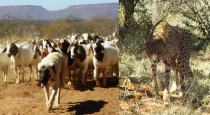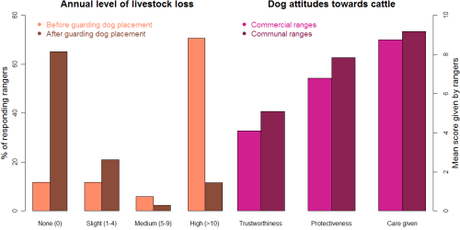
Left: An Anatolian shepherd (a Turkish breed improved in the USA) guiding a herd of boer goats whose flesh is much appreciated by people in Namibia and South Africa. Right: A cheetah carrying a radio-transmitter, within a project assessing range movements of this feline for the Cheetah Conservation Fund. Cheetahs refrain from moving close to the herds when the latter are looked after by the guardian dogs. Photos courtesy of Laurie Marker.
Another corker from Salva. He’s chosen a topic this week that’s near and dear to my brain – the conservation of higher-order predators. As ConBytes readers will know, we’ve talked a lot about human-predator conflict and the inevitable losers in that battle – the (non-human) predators. From dingos to sharks, predator xenophobia is just another way we weaken ecosystems and ultimately harm ourselves.
–
Rural areas devoted to livestock are part of the natural landscape, so it is inevitable (as well as natural) that predators, livestock and humans interact in such a mosaic of bordering habitats. However, their coexistence remains an unresolved conservation problem.
When two species, people, political parties, enterprises… want the same thing, they either share it (if possible) or one side eliminates the competitor. The fact that proteins are part of the diet of humans and other carnivore species has resulted in a trophic drama that goes back millennia. Nowadays, predators like eagles, coyotes, lions, wolves and raccoons are credited for attacks on cattle and poultry (and people!) in all continents. This global problem is not only economic, but interlaces culture, emotion, policy and sanitation (1-4). For instance, some carnivores are reservoirs of cattle diseases and contribute to pathogen dispersal (5, 6).
Management options
Managers of natural resources have implemented three strategies to handle these sorts of for livestock breeders in general (7). Those strategies can be complementary or exclusive on a case-by-case basis, and are chosen following cost-benefit assessments and depending on the conservation status of the predator species involved. (i) ‘Eradication’ aims to eliminate the predator, which is regarded as noxious and worthless. (ii) ‘Regulation’ allows controlled takes under quota schemes, normally for pre-defined locations, dates and killing methods. ‘Preservation’ is applied in protected areas and/or for rare or endangered species, and often requires monitoring and measures set to prevent illegal harvest or trade. Additionally, many livestock breeders receive money to compensate losses to predators (8).
Many experts now advocate non-lethal (preventive) measures that modify the behaviour of people, livestock or predators (2, 7). The use of livestock-guarding dogs is one of those preventive measures (9). As an example, Laurie Marker (director of the Cheetah Conservation Fund) et al. (10) studied the use of 117 Anatolian shepherds adopted by Namibian rangers between 1995 and 2002 (Fig. 1). In this African country, cheetahs (Acinonyx jubatus) selectively forage on small-sized cattle and juveniles. Despite this feline being protected nationally, Namibian laws authorise rangers to shoot cheetahs in situations of risk to people and their properties, with more than 6,000 cheetahs having been killed in the 1980s alone (11). Through face-to-face interviews, Marker found that since the arrival of the Anatolian shepherds, > 70 % of the rangers perceived a pronounced reduction in cattle mortality (10). Although, the use of livestock-guarding dogs has worked out fine in many places worldwide, it is no panacea. In many other instances, the dogs dissuade some predator species and not others from harassing the livestock, or are only effective in combination with other measures (7, 9).

Figure 1. Results of interviews taken of Namibian livestock farmers following adoption of Anatolian shepherds to protect their goats and sheep from cheetah attacks (10). The histogram to the left shows the number of killed cattle (in four categories of loss) before and after dog placement. The presence of dogs resulted in an increase in the percentage of farmers reporting no losses, and in a reduction in those reporting > 10 kills. The histogram to the left shows that farmers were less happy with dogs that chased, played with or bit the cattle (‘Trustworthiness’), but liked it better when the dogs displayed attitudes of wanting to be next to the cattle (‘Care given’) or aggression against intruders (‘Protection’). A similar pattern emerged in commercial (large herds occupying an average of > 9000 ha) and communal (small herds taken care of by families) farms; in both cases, farmers release their cattle to forage freely during the day and keep them in a shed during the night. Marker’s (10) study took place over 7 years, starting in 1995 with 10 Anatolian shepherds brought from the USA and bred in Namibia, to a population of 145 individuals. To reinforce their guarding tasks, female dogs weaned and reared their offspring for 6 to 8 weeks next to the cattle sheds.
Science and emotion
A citizen’s perspective over an environmental problem depends on how far the individual is from that problem. For instance, the number of people in favour of wolf conservation programmes increases with the distance separating them from wolf territories (12). Besides, a rancher’s rejection of carnivores does not diminish proportionally with investments to mitigate the problem (2), because essentially no one is happy about being near an animal ‘enemy’. The scientist’s perspective of the same problem underlines the ecological function of predators which, ironically, becomes self-evident after their extirpation unleashes trophic cascades that collapse entire ecosystems (13), or when predators are re-introduced to restore degraded ecosystems (14).
Two aspects seem fairly relevant. On one hand, avoiding predator attacks within farms (through guardian dogs, fencing, electrified barriers, visual/chemical repellents) is as important as managing (and understanding the functioning of) the natural landscape outside the farms [CJAB's note: sound familiar?]. Thus, European wolves kill fewer cattle where wild ungulates are more abundant (15), or lions in Botswana turn from wild ungulates to livestock during the wildebeest and zebra migration seasons (16). On the other hand, the value of predators is enormous globally as icon species of the conservation movement, but they are often little valued or viewed negatively at a local level (8). The reality is that our coexistence with other predators has been, is and will be competitive. It is important that livestock farmers receive compensation worth at least as much as their losses, and participate in conservation programmes (e.g., being paid to do or support monitoring), but management options will always need to analyse those educational and social factors that shape how local communities perceive the toothed conflict.
–
References
- Bergstrom, B. J. (2011). Endangered wolves fall prey to politics. Science, 333: 1092-1092
- Dickman, A. J. (2010). Complexities of conflict: the importance of considering social factors for effectively resolving human-wildlife conflict. Animal Conservation, 13: 458-466
- Kellert, S. R. y otros autores (1996). Human culture and large carnivore conservation in North America. Conservation Biology, 10: 977-990.
- Shivik, J. A. (2006). Tools for the edge: What’s new for conserving carnivores. BioScience, 56: 253-259
- McDonald, R. A. y otros autores (2008). Perturbing implications of wildlife ecology for disease control. Trends in Ecology and Evolution, 23: 53-56
- Thirgood, S. (2009). New perspectives on managing wildlife diseases. Journal of Applied Ecology, 46: 454-456
- Treves, A. y Karanth, K. U. (2003). Human-carnivore conflict and perspectives on carnivore management worldwide. Conservation Biology, 17: 1491-1499
- Dickman, A. J. y otros autores (2011). A review of financial instruments to pay for predator conservation and encourage human-carnivore coexistence (vol 108, pg 13937, 2011). Proceedings of the National Academy of Sciences of the USA, 108: 19836-19836
- Gehring, T. M. y otros autores (2010). Livestock protection dogs in the 21st Century: Is an ancient tool relevant to modern conservation challenges? BioScience, 60: 299-308
- Marker, L. L. y otros autores (2005). Perceived effectiveness of livestock-guarding dogs placed on Namibian farms. Rangeland Ecology & Management, 58: 329-336
- Marker, L. L. y otros autores (2003). Aspects of the management of cheetahs, Acinonyx jubatus jubatus, trapped on Namibian farmlands. Biological Conservation, 114: 401-412
- Karlsson, J. y Sjostrom, M. (2007). Human attitudes towards wolves, a matter of distance. Biological Conservation, 137: 610-616.
- Estes, J. A. y otros autores (2011). Trophic downgrading of Planet Earth. Science, 333: 301-306
- Ritchie, E. G. y otros autores (2012). Ecosystem restoration with teeth: what role for predators? Trends in Ecology and Evolution, 27: 265-271
- Meriggi, A. y Lovari, S. (1996). A review of wolf predation in southern Europe: Does the wolf prefer wild prey to livestock? Journal of Applied Ecology, 33: 1561-1571
- Valeix, M. et al. (2012). Behavioural adjustments of a large carnivore to access secondary prey in a human-dominated landscape. Journal of Applied Ecology, 49: 73-81

